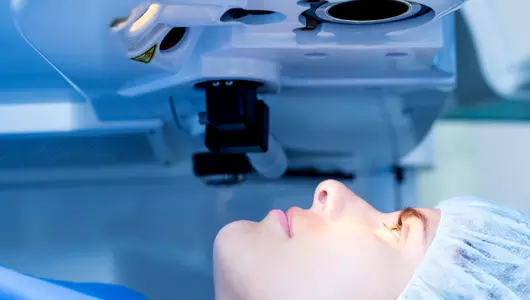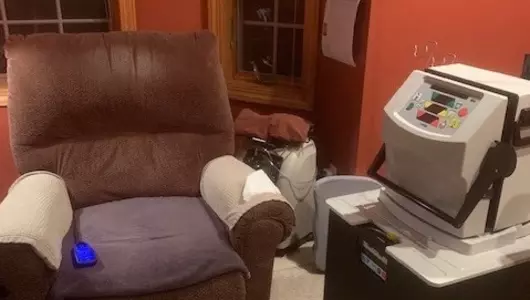
5 signs your body is saying 'See an orthopedic surgeon'
Aches and pains are a normal part of life, especially as we age. So, how long should you grin and bear it before seeing an orthopedic surgeon?
Listening to your body is key, says orthopedic surgeon Thomas Dudley, MD, who specializes in conditions of the bones, joints, ligaments, tendons and muscles, at Gundersen St. Elizabeth's Hospital and Clinics. "I see such variability in pain tolerance, so I always tell my patients to trust their good judgment," he says.
However, it may not always be obvious or easy to identify a serious orthopedic problem, especially if you’ve become used to living in constant pain over time.
Signs you need to see an orthopedic doctor or surgeon
When the symptoms you’re experiencing become unbearable or they get in the way of your everyday life, try tuning in to your body’s natural red flags telling you it’s time to see an orthopedic doctor or surgeon. Not sure what to look for? Here are five clear signs you should pay close attention to and get a consultation appointment scheduled with Orthopedics at Gundersen Health System.
- Sudden onset of pain, swelling or stiff joints
This is often one of the more obvious indications of an orthopedic-related problem. Watch for pain, swelling or stiffness that is not only uncomfortable but also cannot be relieved just by modifying activities, icing the bothersome area, resting or taking over-the-counter pain medication.
- Increasingly achy or numb joints
Take notice of joint pain or numbness that becomes more intense or severe to the point of interfering with daily, routine activities, such as holding a coffee cup, cleaning around the house or climbing stairs. Even simple tasks can start becoming too difficult or impossible to complete because of problematic joints.
- Muscle, tendon or ligament injuries
Signs of these injuries include extreme pain, spasms, swelling and restricted movement or function of the affected area. You’ll especially want to seek further evaluating when you hear and feel sensations of popping or catching in a joint and/or the joint lacks stability or feels unsteady with any movement.
- Pain that keeps you awake at night
"Pain-somnia," as it’s often called, or trouble with falling and staying asleep is more likely to be experienced by people with joint pain and arthritis. According to experts, joint pain can be significantly worse at night, which is likely due to laying in one spot for an extended amount of time for sleeping and the effects of circadian rhythm, or the mental, physical and behavioral changes humans naturally experience during hours of sunlight and darkness across a 24-hour cycle. Continuous disrupted sleep can have drastic, negative impacts on physical and mental health, which also exacerbates joint pain symptoms.
- Infection near an injury with related symptoms
Signs of infection with an injury include soreness, redness, warm skin to the touch, swelling, fever and drainage/pus secretions. Do not wait to treat an infection as it can quickly progress to sepsis, which is the body’s life-threatening response to untreated infections and is considered an urgent medical emergency. Seek emergency medical care immediately if you experience any of the following symptoms along with a suspected infection: high heart rate or weak pulse, persistent high fever, shivering or feeling very cold, shortness of breath, extreme pain or discomfort, and clammy or sweaty skin.
Will I need orthopedic surgery?
Although scheduling an appointment with an orthopedic surgeon or doctor may sound like serious doom and gloom, it's important to know that surgery is often the last resort. In fact, roughly 70% of orthopedic injuries can be effectively treated without needing any surgery at all.
"In the absence of trauma or a ligament injury, there are many orthopedic conditions that can be managed in a non-operative fashion," states Dr. Dudley.
Non-surgical treatments can range from identifying an appropriate diagnosis and monitoring the condition without additional intervention to more conservative treatment options with a goal of addressing symptoms directly and lessening the likelihood of progression.
For example, if arthritis is the underlying cause of knee, hip or shoulder pain, conservative treatment options may include activity modification, exercise or physical therapy, over-the-counter pain medications, walking support equipment, weight loss or joint injections.
"One of the best things you can do to lessen pain and discomfort from arthritic conditions is to keep moving," advises Dr. Dudley. "You may have to modify your activity for knee or hip arthritis but having these conditions does not mean you have to give up having an active lifestyle."
Dr. Dudley suggests low-impact, cross-training activities such as swimming, biking or using the elliptical.
In some situations, orthopedic surgery may be the best solution for fixing or improving your joint condition, especially if conservative treatment options are ineffective at providing relief. Our orthopedic experts will work with you to identify your best treatment options and help you get back to living a happier, healthier, pain-free life.
Orthopedic frequently asked questions (FAQs)
- Q: Do I need a referral to see an orthopedic doctor or surgeon?
A: You can visit an orthopedic doctor or surgeon at Gundersen without needing a referral; however, if you’re feeling uncertainty regarding your joint pain or other symptoms, talk to your primary care provider first and they will happily guide you or advise you on the next best steps.
- Q: What is the difference between an orthopedic doctor and surgeon?
A: Orthopedic doctors, also called orthopedists, and orthopedic surgeons both specialize in diagnosing, treating and preventing orthopedic-related musculoskeletal conditions; however, surgeons can also perform surgery when necessary. Connect with our orthopedic providers and get an appointment scheduled today.
Remember: You don't need to suffer through living with lingering pain any longer. Listen to your body and take the first step towards a pain-free life that you love. Gundersen orthopedic doctors and surgeons see patients at more than a dozen locations in Wisconsin, Minnesota and Iowa—and they’re ready to help you. Find a location near you.
Related articles

Exploring the benefits of red light therapy

Rheumatoid arthritis vs. lupus: What’s the difference?

LASIK eye surgery: Is it right for me?

Empower your health: The freedom of home dialysis over in-center hemodialysis